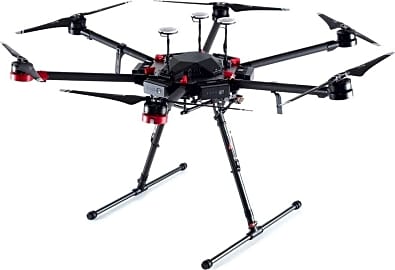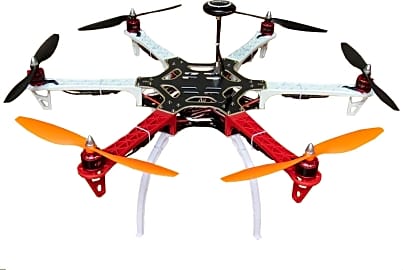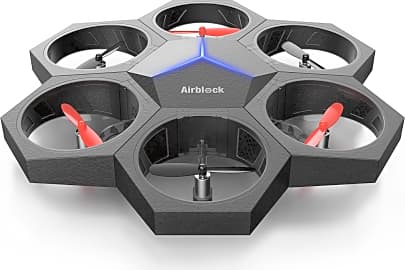The 6 Best Hexacopters

This wiki has been updated 41 times since it was first published in October of 2015. When it comes to reliability and carrying capacity, six rotors are better than four. Unlike standard quadcopters, many high-end hexcopters can continue to fly even if a rotor fails. They are also more stable in windy conditions. We have scoured the market to find the best models for both professional photographers and beginner pilots who just want something to play around with. When users buy our independently chosen editorial selections, we may earn commissions to help fund the Wiki.
Editor's Notes
May 01, 2020:
While there are a plethora of quadcopters in every price range available on the market, the selection of hexacopters is a different story. In fact, there are very few, if any ready-to-fly high- or mid-grade hobbyists models available, which is why they are notably absent from this list.
For professional photographers and cinematographers, we have the Yuneec H920 Plus and DJI Matrice 600 Pro. Despite coming for a lower price, though far from what could be considered affordable for the average person, the H920 Plus comes with a premium camera capable of shooting 4K video and 16MP stills. Conversely, you'll have to buy a camera separately with DJI Matrice 600 Pro. That being said, the latter offers a bigger payload and higher top speed than the Yuneec, so if you have the money and need to record fast-moving subjects, it is probably a better choice. Both fold up for transport and can continue to fly if one motor fails.
On the opposite end of the spectrum we have a few budget-priced, hobby-grade models. These are the MJX X600, Makeblock Airblock, and Mota Pro Live-5000. Generally, most drones should never be piloted by kids younger than 14 years old due to the possibility of injuring themselves or others. That being said, the Makeblock Airblock is actually designed for children as young as eight. This is partially due to its dense foam construction, and partially due to the thick prop guards. Much more than a simple hexacopter, it boasts the ability to be configured as a hovercraft, as well as a variety of other custom forms, and it assembles and disassembles easily via magnets. Additionally, it also offers the ability to program your own stunts on the associated app, helping to teach kids basic coding skills. It would make a great accompaniment to other coding toys and programmable robots.
Falling in between the two categories above, we have the Hobbypower DIY F550, which is a build-it-yourself kit. This one is best suited for people who enjoy tinkering with things and have the patience and interest in putting something together themselves. It must be noted that you'll have to buy additional items to get this hexacopter up and flying, as the kit doesn't include a radio control system or a battery.
Special Honors
Freefly Alta 8 Another model designed for professional cinematographers, the Alta 8 can carry the heaviest of cameras while still remaining stable in the air, thanks to a max payload of 20 pounds, and it remains stable in windy conditions. It offers 35 minutes of flight time per charge and folds up for travel. Unfortunately, the price, which is more than what most people spend on a used car, puts it out of range for the average Joe. freeflysystems.com
DJI Agras MG-1P If you need to capture aerial shots from multiple angles at once, the Agras MG-1P is the way to go. You can control up to five drones from a single controller at distances up to 1.8 miles, and it comes equipped with a 123-degree field-of-view wide-angle camera. It boasts redundant communication systems and the ability to fly even if one motor goes out help to minimize the possibility of a crash. dji.com
A Brief History Of Hexacopters
Breguet's design was the first rotary wing aircraft to achieve this feat.
While it may look foreign to many drone operators, the hexacopter has a lot in common with the quadcopter design it's based on. The quadcopter design itself dates back to 1907, when French aircraft builder Louis Breguet invented a four-rotor helicopter capable of lifting itself a few feet off the ground. Breguet's design was the first rotary wing aircraft to achieve this feat.
Some early aircraft designers promoted the multi-rotor layout as a superior alternative to the dominant fixed-wing design, but their confidence was not rewarded in testing, where multi-rotors proved unstable and difficult to pilot. The multi-rotor design lay dormant for decades until a proliferation of affordable and lightweight flight controllers, GPS units, cameras, and accelerometers in the late 2000s made it a practical format for consumer drone manufacturers to adopt.
While the multi-rotor design was out of favor for much of the 20th century, the concept of unmanned flight was not, and the American army began researching the military applications soon after World War I. Called drones because of the buzzing sound made by the first unmanned military aircraft, today's consumer drones are often powered by batteries. Battery power is not yet feasible for use by larger aircraft, but for hexacopters it is ideal.
The market for multi-rotor consumer drones exploded in the mid-2010s, and many potential drone applications were discovered. On film shoots, photography-focused drones were used instead of cost-prohibitive helicopters. Hexacopters are preferred to quadcopters in some film and photography applications because of their superior stability, power and precision.
Hexacopters are highly maneuverable and capable of carrying larger batteries and heavier payloads than their quadcopter counterparts. They're also capable of making a controlled landing even if a single motor fails — a valuable feature when expensive camera equipment is aboard. Cameras on auto-follow drones are also used to track targets, with increasingly sophisticated autonomous flight technology enabling them to dodge obstacles in their path.
The Rules Governing Hexacopter Flight
The rules and regulations that govern the use of quadcopters also apply to their hexacopter brethren.
Chief among those rules is the FAA's prohibition on flying over other people without approval. In addition to raising privacy questions, flying drones over populated areas can be dangerous. If the drone experiences motor failure, it could fall in mid-flight. Because hexacopters can perform a controlled landing with one of their motors disabled, they are generally regarded as safer for flying over people and events. While their larger footprint isn't suitable for all uses, hexacopters are preferred by many commercial operators.
The FAA advises that rotor guards significantly reduce the risk associated with flying over people.
Even with a hexacopter, you must apply for a waiver from the FAA before flying over people. If you plan to fly in public areas frequently, you may consider investing in a drone with rotor guards. The FAA advises that rotor guards significantly reduce the risk associated with flying over people. These guards can add significant bulk to the craft, particularly with hexacopters, which have two extra rotors to protect.
FAA registration is required for most drones over a certain size threshold. However, the guidelines governing certification of unmanned aircraft may change from time to time, so it's best to check with the administration before flying your drone anywhere but in your own living room.
The FAA maintains a list of rules for safe drone operation. The administration advises flying no higher than 400 feet off the ground, and keeping the drone in sight at all times to avoid losing signal and control of the flight path. Most consumer drones feature auto-descent programs that trigger in the event of signal loss, but it's still unwise to push a hexacopter to the maximum distance as determined by the manufacturer.
The FAA also warns against flying in the vicinity of airports, manned aircraft, and emergency workers. After commercial drones were detected by firefighters near the scene of a southern California wildfire in 2015, authorities were twice forced to suspend their operations as a precaution. While drones may appear harmless next to the might of large, low-flying firefighting air tankers and helicopters, a mid-air collision could actually cause significant damage, according to the U.S. Forest Service.
Drone Technology Basics
The first unmanned aerial vehicle looked nothing like today's advanced hexacopters and military drones. In fact, that early Austrian military craft was essentially just a balloon filled with explosives. Today's military UAVs cost millions to manufacture, and feature advanced flight computers and satellite control systems that allow the military to remotely pilot them from almost anywhere in the world.
By definition, hexacopters are rotorcraft, rather than fixed-wing aircraft, like most airplanes.
Though they may look wildly different, modern consumer drones and hexacopters have a lot in common with these futuristic fighting machines, including GPS guidance, live video feeds, and precision controls. The term drone applies broadly to all unmanned military, consumer, and commercial aircraft, while UAV specifically refers to the high-end commercial and military vehicles typically deployed by businesses and governments. Hexacopters are drones that have six rotors.
Military UAVs are guided by satellite data link, except on takeoff, where the reliability and low-latency of radio is preferred. Consumer drones are typically controlled by radio or, in some cases, programmed, GPS-based guidance.
Most consumer drones are in the quadcopter configuration. Hexacopters are similar to quadcopters, but they use six motors for propulsion, rather than four. These additional motors lend the aircraft stability and reliability, but may also significantly increase weight.
By definition, hexacopters are rotorcraft, rather than fixed-wing aircraft, like most airplanes. Hexacopter operators maintain control by varying the speed of each rotor. Helicopters, by contrast, achieve control by varying the pitch of their blades.
The Northrop Grumman Global Hawk is generally regarded as the most powerful UAV in existence. Propelled by a Rolls-Royce jet engine, the Global Hawk can reach the outer edge of Earth's atmosphere, where it conducts surveillance operations for the Air Force for as long as 30 hours. The Global Hawk is also used in NASA planet surveys.











